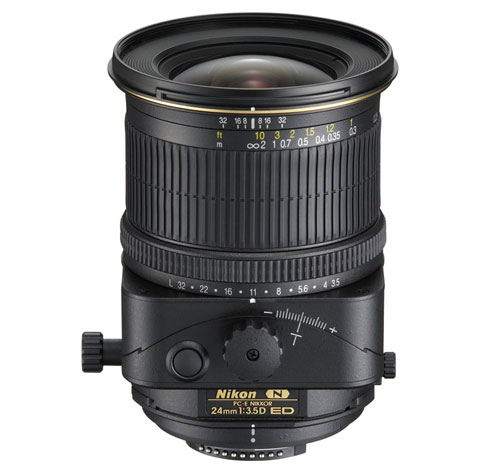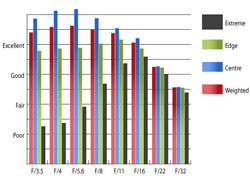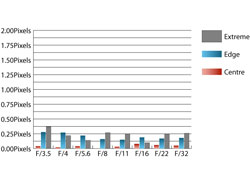Nikon 24mm f/3.5D ED PC-E
 |
| In this review Gary Wolstenholme takes a look at a highly specialised wideangle lens allowing control of perspective and the focal plane via tilt and shift movements. |
Nikon's 24mm f/3.5D PC-E lens is fixed focal length wide angle ideally suited to architecture and landscape applications where control over perspective and the focal plane are important. This is a highly specialist lens, and comes at a highly specialist price of around £1370. No third party lens manufacturers currently offer an equivalent optic, so if you need the features of this lens, this is currently the only option.
Nikon 24mm f/3.5D ED PC-E: Handling and features
To accommodate up to 11.5mm of shift and up to 8.5degrees of tilt either way this lens has to be able to cover a much larger imaging area than that of even Nikon's FX format cameras, which explains why this lens has quite a modest maximum aperture of f/3.5, despite the £1000+ price tag.
Each movement will allow the user to control the effect of converging lines, such as vertical wall on buildings, or to increases of decrease the depth of field for a given aperture along a certain focal plane by tilting the lens. Dials on either side of the lens give precise control of each movement, and a small dial allows the user to control the amount of resistance on each control, or to lock it in place. In use I occasionally found these smaller tension controls a little difficult to use, or even to access. This is especially true of the one controlling the amount of resistance for the shift control, as when the lens is rotated 90degrees, it is very close to the front of the prism housing on my D700 camera. I can imagine this will be less of an issue on Nikon top-line bodies, as the prism housing does jut out as far on those cameras.
The lens is manual focus, as the tilting and shifting action makes it impossible to motorise the focus action of the lens. The manual focus ring is nicely damped, giving just the right amount of resistance to make fine adjustments possible. A hyperfocal scale is provided on the lens barrel for apertures of f/8 and smaller. The scale could do with being a little more spread out to make setting the hyperfocal distance a little clearer, although I suppose this scale is to be ignored when using tilt movements anyway. A depth of field preview button is located next to the tilt control, which stops down the lens when pressed once, only opening the aperture once it is pressed again. This is an especially nice touch which makes it much easier to accurately set the lens movements how you desire.
Just behind the focus ring is an aperture ring. To use the lens in program or shutter priority modes, the aperture ring needs to be turned past f/32, to where it is marked 'L', and the ring will lock in place. In aperture priority and manual modes rotating the aperture ring changes the setting and the correct aperture is shown on the camera display. A small lever is located close to the lens mount, which allows the lens to be rotated through 90degrees, clockwise or anticlockwise. There are also two intermediate stops during rotation, just in case you wish to use the movements at angle.
Overall the controls feel sturdy and positive, making this complex lens very pleasant to use.
Nikon 24mm f/3.5D ED PC-E: Performance
Across the normal 35mm image area, this lens performs exceedingly well, producing images with excellent centre sharpness and very good corners from wide open. In fact the centre sharpness is so high, I had to extend my graph to accommodate it! This is a very, very sharp lens.
Towards the extreme edge of the image circle, the quality falls off somewhat at wider apertures, with the quality being quite poor at the extreme edges at f/3.5. This will only be visible at maximum shift or tilt though, so it may just be worth exercising care when using these movements at wide apertures. Stopping the lens down improves the quality towards the extreme edge of the image circle, with the quality being very good throughout at f/16. At smaller apertures diffraction begins to take a bite out of the sharpness, with quality remaining good at f/22 and a little soft by comparison at f/32.
Levels of chromatic aberrations barely exceed 0.4 pixel widths, even at the extreme edge of the image circle. Occasionally some red/green fringing can be seen along very high contrast edges towards the edges of the imaging circle, but I rarely found it to be too much of an issue in practice.
Due to the nature of the lens, it isn't possible to measure the falloff across the whole image circle with Imatest. Across the normal 35mm imaging area with the lens centred, the corners of the image at 1.13 stops darker than the image centre at f/3.5. I did notice in use that the brightness through the viewfinder would drop the more the lens is tilted and shifted. Stopping down to f/8 appears to give even illumination across much of the image circle.
As is typical for wide angle lenses, there is some barrel distortion, although I had hoped for slightly less with the lens being a prime. Imatest recorded 2.31% barrel distortion. Luckily the distortion pattern is uniform and very easy to correct in Photoshop.
As with Nikon's other lenses sporting their Nano Crystal Coatings, the lens is very resistant to flare and ghosting. Occasionally strong point sources of light out side the frame will cause a little flare across the frame, but it is normally suppressed sufficiently to be of little consequence.
Nikon 24mm f/3.5D ED PC-E: Verdict
During testing this lens has proved itself to be an exceptional quality optic capable of producing high resolution images, with great contrast and also with the added creative benefits of tilt and shift lens movements.
Its only weakness appears to be the sharpness towards the extremes of the imaging circle at wide apertures, but so long as the user is aware of this trait it can easily be worked around. This isn't the kind of lens you'd be using to snap sports at wide apertures anyway.
In my opinion the high price tag is justified. This is a specialised lens, which does the job as intended with aplomb.
 |
| "The Nikon 24mm f/3.5D ED PC-E is of superb quality and comes highly recommended." |
 Superb sharpness
Superb sharpness Excellent controls
Excellent controls  Great build quality
Great build qualityNikon 24mm f/3.5D ED PC-E: Cons
 Quality at extremes of the imaging circle at wide apertures
Quality at extremes of the imaging circle at wide apertures Tensioning controls sometimes hard to access on my D700
Tensioning controls sometimes hard to access on my D700| FEATURES |  |
| HANDLING |  |
| PERFORMANCE |  |
| VALUE |  |
| OVERALL |  |
Nikon 24mm f/3.5D ED PC-E: Lens specification
| Price | £1,370.00 |
| Contact | www.nikon.co.uk |
| Filter size | 77mm |
| Format | Full-frame |
| Construction | 13 elements in 10 groups |
| Angle-of-view | 84° (maximum 101° when fully shifted) |
| 35mm equivalent focal length (on APS-C body) | 36mm |
| Internal focusing | Yes |
| Image stabilisation | No |
| Minimum focus | 21cm |
| Maximum aperture | f/3.5 |
| Minimum aperture | f/32 |
| Weight | 730g |
| Size | 82.5 x 108mm |
| In the box | Bayonet Hood HB-41, Flexible Lens Pouch CL-1120 |
The Nikon 24mm f/3.5D ED PC-E costs around £1370 and is available from Warehouse Express here:
Nikon 24mm f/3.5D ED PC-E
Add your message
Login required
Please login here or if you've not registered, you can register here. Registering is safe, quick and free.
Please login here or if you've not registered, you can register here. Registering is safe, quick and free.
photodo Stats
1102 lenses
428 MTF tests
74 in-depth photodo reviews
100+ users join each day
Help the lens community by reviewing or rating a lens today via our lens search
428 MTF tests
74 in-depth photodo reviews
100+ users join each day
Help the lens community by reviewing or rating a lens today via our lens search
Latest Lens Reviews
- Chinon 28mm f/2.8 Vintage Lens Review
- Canon EF 70-200mm f/4L IS II USM Lens Review
- Samyang AF 85mm f/1.4 EF Review
- Sigma 70mm f/2.8 DG Macro Art Review
- Samyang AF 24mm f/2.8 FE Review
- Meike 50mm f/1.7 Review
- Tamron 70-210mm f/4 Di VC USD Review
- Lensbaby Burnside 35mm f/2.8 Review
- Asahi Super Takumar 50mm f/1.4 Review
- Asahi Super-Multi-Coated Takumar 135mm f/3.5 Review





